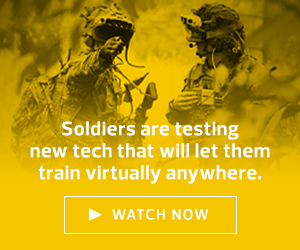Army Training Gets Modernized with Virtual Reality
The STE has been using gaming technology, including “playing games to get through some of their training capability to synchronize some of their efforts,” Gervais said.
“We’ve also seen more use of the virtual capability to help units train, to help them continue preparations,” she added.
The Army is conducting a study to help update its requirements for the synthetic training environment, according to National Defense magazine.
“We definitely need help from our industry partners in this area because it is time to change a 1970s technology that has evolved over time,” Gervais said. “It will no longer meet our needs and we’re looking for a revolutionized training capability for our live training environment.”
A synthetic training environment can help the Army better train soldiers remotely for combined arms training. “We can’t effectively replicate the operational environment for the future” without new technologies, Gervais said. “Creating a synthetic training environment in which a unit may train will give back to the leaders some of the time they have spent in planning, preparing, executing and assessing training.”













